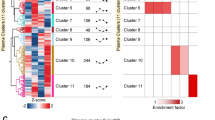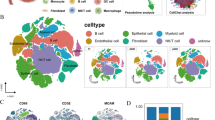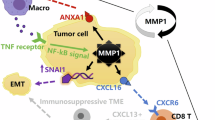Abstract
Elevated expression of type IV collagenases (MMP-2 and MMP-9) has been strongly correlated with tumour progression and metastasis in various tumours. Here, we analysed expression and activation of these MMPs in non-tumourigenic HaCaT cells and the malignant HaCaT variant II-4rt. In monolayer cultures, both cell types secreted latent MMP-2 (proMMP-2) in comparable amounts, while MMP-9 production was clearly higher in II-4rtcells. Upon contact with fibrillar collagen type I the malignant II-4rtcells, but not the HaCaT cells, gained the capability to activate proMMP-2. This process is shown to be membrane-associated and mediated by MT1-MMP. Surprisingly, all membrane preparations from either HaCaT cells or II-4rtcells grown as monolayers, as well as within collagen gels, contained considerable amounts of active MT1-MMP. However, within collagen gels HaCaT cells showed significantly higher TIMP-2 levels compared to II-4rtcells. This indicates that TIMP-2 might play a central role for MT1-MMP-mediated gelatinolytic activity. Indeed, collagen type I-induced MT1-MMP-mediated proMMP-2 activation by II-4rtmembranes could be completely abolished by an excess of TIMP-2. In conclusion, our data suggest that MT1-MMP-mediated proMMP-2 activation might be associated with malignant progression of epidermal tumour cells. © 2000 Cancer Research Campaign
Similar content being viewed by others
Article PDF
Change history
16 November 2011
This paper was modified 12 months after initial publication to switch to Creative Commons licence terms, as noted at publication
References
Azzam HS and Thompson EW (1992) Collagen-induced activation of the Mr 72,000 type IV gelatinase in normal and malignant fibroblastoid cells. Cancer Res 52: 4540–4544
Birkedal-Hansen H, Moorie WGI, Bodden MK, Birkedal-Hansen B, DeCarlo A and Engler JA (1993) Matrix metalloproteinases: a review. Crit Rev Oral Biol Med 4: 197–250
Boukamp P, Petrusevska RT, Breitkreutz D, Hornung J, Markham A and Fusenig NE (1988) Normal keratinization in a spontaneously immortalized aneuploid human keratinocyte cell line. J Cell Biol 106: 761–771
Boukamp P, Stanbridge EJ, Foo DY, Cerutti PA and Fusenig NE (1990) c-Ha-ras oncogene expression in immortalized human keratinocytes (HaCaT) alters growth potential in vivo but lacks correlation with malignancy. Cancer Res 50: 2840–2847
Breitkreutz D, Schoop VM, Mirancea N, Baur M, Stark H-J and Fusenig NE (1998) Epidermal differentiation and basement membrane formation by HaCaT cells in surface transplants. Eur J Cell Biol 75: 273–286
Brown PD, Levy AT, Margulies IM, Liotta LA and Stetler-Stevenson WG (1990) Independent expression and cellular processing of Mr 72,000 type IV collagenase and interstitial collagenase in human tumorigenic cell lines. Cancer Res 50: 6184–6191
Butler GS, Will H, Atkinson SJ and Murphy G (1997) Membrane-type-2 matrix metalloproteinase can initiate the processing of progelatinase A and is regulated by the tissue inhibitors of metalloproteinases. Eur J Biochem 244: 653–657
Butler GS, Butler MJ, Atkinson SJ, Will H, Tamura T, Schade van Westrum S, Crabbe T, Clements J, d'Ortho MP and Murphy G (1998) The TIMP-2 membrane type metalloproteinase receptor regulates the concentration and efficient activation of progelatinase A. J Biol Chem 273: 871–880
Cao J, Rehemtulla A, Bahou W and Zucker S (1996) Membrane-type matrix metalloproteinase 1 activates pro-gelatinase A without furin cleavage of the N-terminal domain. J Biol Chem 271: 30174–30180
Carlson SG, Fawcett TW, Bartlett JD, Bernier M and Holbrook NJ (1993) Regulation of the C/EBP related gene gadd153 by glucose deprivation. Mol Cell Biol 13: 4736–4744
Collier IE, Wilhelm SM, Eisen AZ, Marmer BL, Grant GA, Seltzer JL, Kronberger He C, Bauer EA and Goldberg GI (1988) H-ras oncogene-transformed human bronchial epithelial cells (TBE-1) secrete a single metalloprotease capable of degrading basement membrane collagen. J Biol Chem 263: 6579–6587
Gilles C, Polette M, Seiki M, Birembaut P and Thompson EW (1997) Implication of collagen type I-induced membrane-type 1 matrix metalloproteinase expression and matrix metalloproteinase-2 activation in the metastatic progression of breast carcinomas. Lab Invest 76: 651–660
Gum R, Lengyel E, Juarez J, Chen JH, Sato H, Seiki M and Boyd D (1996) Stimulation of 92-kDa gelatinase B promoter activity by ras is mitogen-activated protein kinase 1 independent and requires multiple transcription factor binding sites including closely spaced PEA3/ets and AP-1 sequences. J Biol Chem 271: 10672–10680
Haas TI, Davis SJ and Madri JA (1998) Three-dimensional type I collagen lattices induce coordinate expression of matrix metalloproteinase MT1-MMP and MMP-2 in microvascular endothelial cells. J Biol Chem 273: 3604–3610
Herron GS, Benda MJ, Clark EJ, Gavrilovic J and Werb Z (1986) Secretion of metalloproteinases by stimulated capillary endothelial cells. J Biol Chem 261: 2814–2818
Itoh Y, Ito A, Iwata K, Tanazawa K, Mori Y and Nagase H (1998) Plasma membrane-bound tissue inhibitor of metalloproteinases (TIMP)-2 specifically inhibits matrix metalloproteinase 2 (gelatinase A) activation on the cell surface. J Biol Chem 273: 24360–24367
Kazes I, Delarue F, Hagege J, Bouzhir-Sima L, Rondeau E, Sraer JD and Nguyen G (1998) Soluble latent membrane-type 1 matrix metalloprotease secreted by mesangial cells is activated by urokinase. Kidney Int 54: 1976–1984
Kurschat P, Zigrino P, Nischt R, Breitkopf K, Steurer P, Klein EC, Krieg T and Mauch C (1999) Tissue inhibitor of matrix metalloproteinase-2 regulates matrix metalloproteinase-2 activation by modulation of membrane-type 1 matrix metalloproteinase activity in high and low invasive melanoma cells. J Biol Chem 274: 21056–21062
Kusukawa J, Sasaguri Y, Shima I, Kameyama T and Morimatsu M (1993) Expression of matrix metalloproteinase-2 related to lymph node metastasis of oral squamous cell carcinomas. A clinicopathologic study. Am J Clin Pathol 99: 18–23
Lehti K, Lohi J, Valtanen H and Keski-Oja J (1998) Proteolytic processing of membrane-type 1 matrix metalloproteinase is associated with gelatinase A activation at the cell surface. Biochem J 334: 345–353
Maquoi E, Noel A, Frankenne F, Angliker H, Murphy G and Foidart JM (1998) Inhibition of matrix metalloproteinase-2 maturation and HT 1080 invasiveness by a synthetic furin inhibitor. FEBS Lett 242: 262–266
Mauch C, Hatamochi A, Scharffetter K and Krieg T (1988) Regulation of collagen synthesis in fibroblast within a three-dimensional collagen gel. Exp Cell Res 178: 493–503
Meade-Tollin LC, Boukamp P, Fusenig NE, Bowen CPR, Tsang TC and Bowden GT (1998) Differential expression of matrix metalloproteinases in activated c-rasHa-transfected immortalized human keratinocytes. Br J Cancer 77: 724–730
Nakamura H, Ueno H, Yamashita K, Shimada T, Yamamoto E, Noguchi M, Fujimoto N, Sato H, Seiki M and Okadea Y (1999) Enhanced production and activation of progelatinase A mediated by membrane-type 1 matrix metalloproteinase in human papillary thyroid carcinomas. Cancer Res 59: 467–473
Okada A, Beloqc JP, Rouyer N, Chenard MP, Rio MC, Chambon P and Basset P (1995) Membrane-type matrix metalloproteinase (MT-MMP) gene is expressed in stromal cells of human colon, breast, head and neck carcinomas. Proc Natl Acad Sci USA 92: 2730–2734
Okumura Y, Sato H, Seiki M and Kido H (1997) Proteolytic activation of the precursor of membrane-type 1 matrix metalloproteinase by human plasmin. FEBS Lett 402: 181–184
Pei D (1999) Identification and characterization of the fifth membrane-type matrix metalloproteinase MT5-MMP. J Biol Chem 274: 8925–8933
Pei D and Weiss SJ (1996) Transmembrane-deletion mutants of the membrane-type matrix metalloproteinase-1 process progelatinase A and express intrinsic matrix-degrading activity. J Biol Chem 271: 9135–9140
Puente XS, Pendas AM, Ilano E, Velasco G and Lopez-Otin C (1996) Molecular cloning of a novel membrane-type matrix metalloproteinase from a human breast carcinoma. Cancer Res 56: 944–949
Pyke C, Ralfkiaer EH, Huhtala P, Hurskaninen T, Dano K and Tryggvason K (1992) Localization of messenger RNA for Mr 72,000 and 92,000 type IV collagenases in human skin cancers by in situ hybridization. Cancer Res 52: 1336–1241
Sato H, Takino T, Okada Y, Shinagawa A, Yamamoto E and Seiki M (1994) A matrix metalloproteinase expressed on the surface of invasive tumor cells. Nature 370: 61–65
Sato H, Takino T, Kinoshita T, Imai K, Okada Y, Stetler-Stevenson WG and Seiki M (1996) Cell surface binding and activation of gelatinase A induced by expression of membrane-type matrix metalloproteinase (MT1-MMP). FEBS Lett 385: 238–240
Seltzer JL, Lee AY, Akers KT, Sudbeck B, Southon EA, Wayner EA and Eisen AZ (1994) Activation of 72-kDa type IV collagenase/gelatinase by normal fibroblasts in collagen lattices is mediated by integrin receptors but is not related to lattice contraction. Exp Cell Res 213: 365–374
Stetler-Stevenson WG, Brown PD, Onisto M, Levy AT and Liotta LA (1990) Tissue inhibitor of metalloproteinase-2 (TIMP-2) mRNA expression in tumor cell lines and human tumor tissues. J Biol Chem 265: 13933–13938
Stetler-Stevenson WG, Aznavoorian S and Liotta LA (1993) Tumor cell interaction with the extracellular matrix during invasion and metastasis. Annu Rev Cell Biol 9: 541–573
Stieneke-Grober A, Vey M, Angliker H, Shaw E, Thomas G, Roberts C, Klenk HD and Garten W (1992) Influenza virus hemagglutinin with multibasic cleavage site is activated by furin, a subtilisin-like endoprotease. EMBO J 11: 2407–2414
Strongin AY, Collier I, Banniko G, Marmer BL, Grant GA and Goldberg GI (1995) Mechanism of cell surface activation of 72-kDa type IV collagenase. Isolation of the activated form of the membrane metalloprotease. J Biol Chem 270: 5331–5338
Takino T, Sato H, Shinagawa A and Seiki M (1995) Identification of the second membrane-type matrix metalloproteinase (MT-MMP2) gene from a human placenta cDNA library. MT-MMPs form a unique membrane-type subclass in the MMP family. J Biol Chem 270: 23013–23020
Tomakidi P, Mirancea N, Fusenig NE, Herold-Mende C, Bosch FX and Breitkreutz D (1999) Defects of basement membrane and hemidesmosome structure correlate with malignant phenotype and stromal interactions in HaCaT-Ras xenografts. Differentiation 64: 263–275
Tsunezuka Y, Kinoh H, Takino T, Watanabe Y, Okada Y, Shinagawa A, Sato H and Seiki M (1996) Expression of membrane-type matrix metalloproteinase-1 (MT1-MMP) in tumor cells enhances pulmonary metastasis in an experimental metastasis assay. Cancer Res 56: 5678–5683
Will H and Hinzmann B (1995) cDNA sequence and mRNA distribution of a novel human matrix metalloproteinase with a potential transmembrane domain. Eur J Biochem 231: 602–608
Will H, Atkinson SJ, Butler GS, Smith B and Murphy G (1996) The soluble catalytic domain of type 1 matrix metalloproteinase cleaves the propeptide of progelatinase A and initiates autoproteolytic activation. J Biol Chem 271: 17119–17123
Yu AE, Hewitt RE, Kleiner DE and Stetler-Stevenson WG (1997) Molecular regulation of cellular invasion – role of gelatinase A and TIMP-2. Biochem Cell Biol 74: 823–831
Zucker S, Drews M, Conner C, Foda HD, DeClerk YA, Langley KE, Bahou WF, Docherty AJP and Cao J (1998) Tissue inhibitor of metalloproteinase- (TIMP-2) binds to the catalytic domain of the cell surface receptor, membrane type 1-matrix metalloproteinase 1 (MT1-MMP). J Biol Chem 273: 1216–1222
Author information
Authors and Affiliations
Rights and permissions
From twelve months after its original publication, this work is licensed under the Creative Commons Attribution-NonCommercial-Share Alike 3.0 Unported License. To view a copy of this license, visit http://creativecommons.org/licenses/by-nc-sa/3.0/
About this article
Cite this article
Baumann, P., Zigrino, P., Mauch, C. et al. Membrane-type 1 matrix metalloproteinase-mediated progelatinase A activation in non-tumorigenic and tumorigenic human keratinocytes. Br J Cancer 83, 1387–1393 (2000). https://doi.org/10.1054/bjoc.2000.1454
Received:
Revised:
Accepted:
Published:
Issue date:
DOI: https://doi.org/10.1054/bjoc.2000.1454



